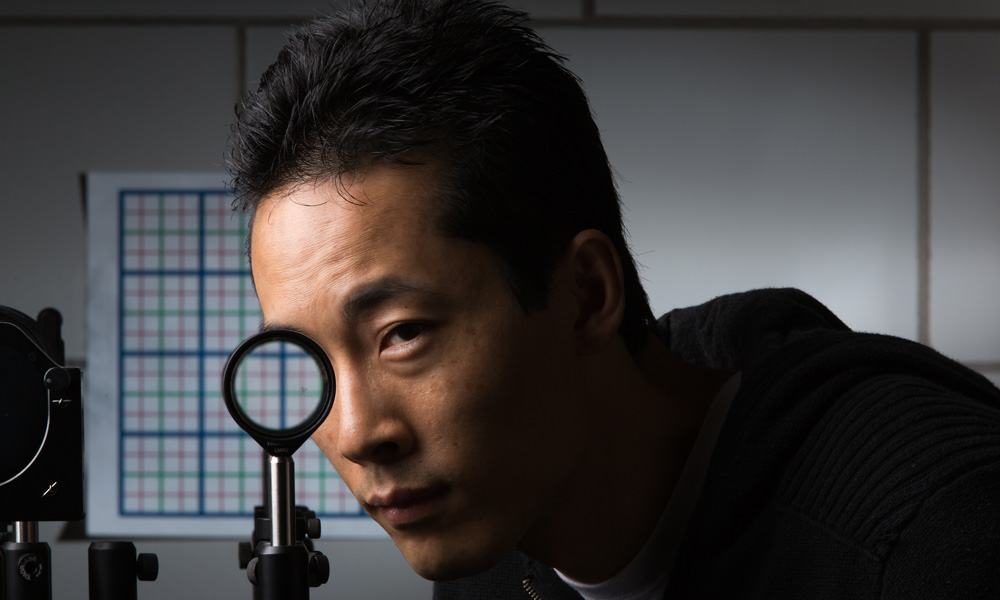Science Seen Physicist and Time One author Colin Gillespie helps you understand your world.
The DIY Invisibility Cloak
Harry Potter brings cutting-edge ideas from quantum physics into the imaginations of a generation of young fiction readers. In previous posts we’ve looked at teleportation, levitation, and solids that can pass through other solids unimpeded (though not yet through brick walls). All three are examples of how quantum mechanics (QM) can make seeming-magic in the real world. Another QM ‘magic trick’ is the invisibility cloak. It comes in various types based on metamaterials. Metamaterials are manufactured with a small-scale structure designed to manipulate light. And there is even a cloak that hides an object from your touch. Its metamaterial conspires to prevent your finger from getting any information about the object’s shape. Like optical cloaks, these QM-based structures are technical to design and make. Most devices made with them are still not practical.
 But now there is a simple low-cost invisibility device. You can build it in your kitchen. It is based on non-QM (or so-called ‘classical’) physics. It uses light-bending principles whose origins date back to French philosophers René Descartes and Pierre de Fermat in the 1600s. They wondered why light seems to bend when it goes into glass or water. Between them they worked out the rule: Light takes the path that takes the shortest time. These days QM undermines the concept that ‘light takes a path’. But Fermat’s rule describes how lenses work in classical terms. And this shows physicists a way to cloak a doughnut-shaped region with lenses. This is why the missing eye.
But now there is a simple low-cost invisibility device. You can build it in your kitchen. It is based on non-QM (or so-called ‘classical’) physics. It uses light-bending principles whose origins date back to French philosophers René Descartes and Pierre de Fermat in the 1600s. They wondered why light seems to bend when it goes into glass or water. Between them they worked out the rule: Light takes the path that takes the shortest time. These days QM undermines the concept that ‘light takes a path’. But Fermat’s rule describes how lenses work in classical terms. And this shows physicists a way to cloak a doughnut-shaped region with lenses. This is why the missing eye.
Science writer Jessica Orwig says:
Physicists at the University of Rochester have created an incredibly versatile cloaking device, which hides things from view. But more importantly, you can make this crazy concealing device at home for under $100.
You will need four lenses with lens holders and one bench (or kitchen table).
Although the rule is old, the idea for this device is new. Science journalist David Barnstone reports that physicist John Howell and doctoral student Joseph Choi developed it after Howell worked on a project with his kids. Hmmm . . . kids ask good questions. And good questions lead to good ideas. So how many physicists does it take to make an invisibility cloak? Only two if one listens to his kids.
Sources:
Jessica Orwig (2104), “How To Make An ‘Invisibility Cloak’ At Home For Under $100”, Business Insider, http://www.businessinsider.com/how-to-make-a-rochester-invisibility-cloak-2014-9
David Barnstone (2014), “ ‘Cloaking’ device uses ordinary lenses to hide objects across range of angles”, Newscenter, University of Rochester, http://www.rochester.edu/newscenter/watch-rochester-cloak-uses-ordinary-lenses-to-hide-objects-across-continuous-range-of-angles-70592/
Other Reading and Viewing:
Karlsruhe Institute of Technology (2014), “Princess and the Pea? Invisibility cloak prevents an object from being felt”, Science Daily, 20 June, http://www.sciencedaily.com/releases/2014/06/140620102314.htm
Joseph Choi & John Howell (2104), “Paraxial Ray Optics Cloaking”, Ithaca: Cornell University Library, http://arxiv.org/abs/1409.4705
Video demonstration, University of Rochester, http://video.businessinsider.com/7ff2ced3-f0c8-4a33-b731-37e549ea6c6b.mp4
How-to-build-it instructions, http://www.businessinsider.com/how-to-make-a-rochester-invisibility-cloak-2014-9
Image credit: University of Rochester

No comments yet.